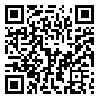BibTeX | RIS | EndNote | Medlars | ProCite | Reference Manager | RefWorks
Send citation to:
URL: http://jhr.ssu.ac.ir/article-1-407-en.html

 , Marjan Ghazisaeedi2
, Marjan Ghazisaeedi2 
 , Leila Shahmoradi *
, Leila Shahmoradi * 
 3, Hosein Karami4
3, Hosein Karami4 
 , Azadeh Bashiri5
, Azadeh Bashiri5 

2- Departmant of Health Information Management, School of Allied Medical Sciences, Tehran University of Medical Sciences, Tehran, Iran
3- Departmant of Health Information Management, School of Allied Medical Sciences, Tehran University of Medical Sciences, Tehran, Iran , Lshahmoradi@tums.ac.ir
4- Departmant of Hematology and Oncology, Mazandaran University of Medical Sciences, Mazandaran, Iran
5- Departmant of Health Information Management,School of Allied Medical Sciences, Tehran University of Medical Sciences, Tehran, Iran
Introduction: In advanced medicine, large amounts of data are produced. However, there is always a gap between their collection and their understanding and interpretation. Thus, the minimum data sets are prepared. Thalassemia major is a chronic genetic blood disorder and the most common genetic disorder in the world. So, the aim of this study was to determine the data set for personal health record of patients with major thalassemia.
Methods: This present applied research was done descriptively by Delphi method. To determine the dataset, the manual health records of thalassemia major patients were first evaluated based on the standard paper forms of the Ministry of Health, and the data required were collected according to the checklist. The questionnaire w first reviewed by a 6-expert team. Its content validity was determined by the team and its reliability by Cronbach's alpha as 96%. Then, a researcher-made questionnaire was prepared and surveyed among 113 experts on blood and oncology specialists around the country (Iran).
Results: from the 126 information element data surveyed, 117 IEDs were identified as the main elements with the agreement of more than 75% in the range of high and very high, while nine elements with the agreement of less than 50% in the range of low and very low were excluded from the elements list of personal health records of thalassemia patients. The information element data with the agreement of 50 to 75 in the range of moderate to high was not found in the survey. Finally, the minimum data set of individual health records of patients with thalassemia major was provided in 9 groups of demographic information, health history information, assessment information, laboratory data, drug information, blood transfusion, physical examinations, immunization (vaccination) and dental care.
Conclusion: In this study, the data elements were defined for personal health record of thalassemia patients. These data elements are considered as an appropriate data set for inclusion in the manual systems and electronic medical records and based on the patients' needs can be changed to be used as a national document.
Received: 2017/12/15 | Accepted: 2018/02/27 | Published: 2018/02/27
| Rights and permissions | |
 |
This work is licensed under a Creative Commons Attribution 4.0 International License. |



